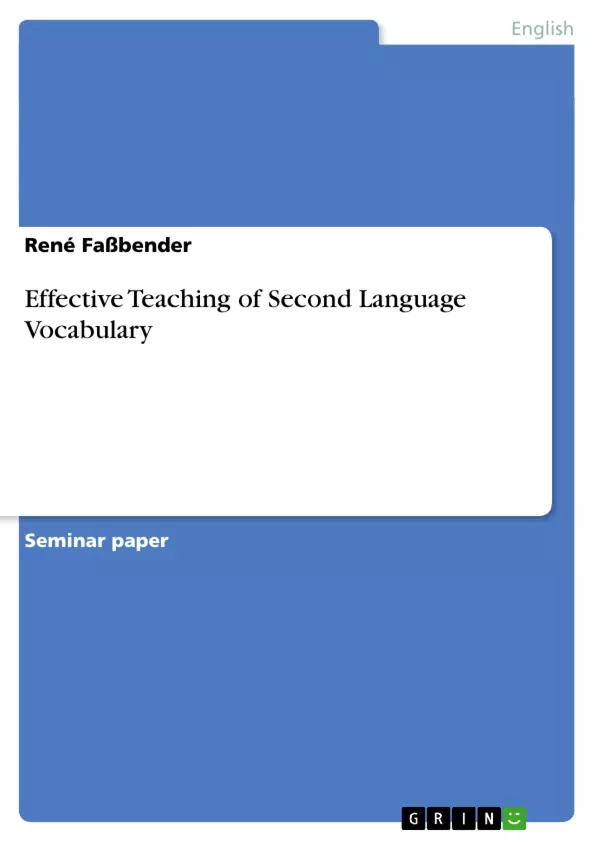Interest in second language vocabulary (SLV) significantly increased in the late 1980s and a considerable number of books concerning themselves with it have been published since then. On the other hand, despite this changed condition, curricula in schools are still considering teaching vocabulary a marginal subject: It is scarcely an issue itself and quite often only mentioned casually when dealing with subjects that are thought to be more demanding and important. However, vocabulary is indeed both demanding and important. Thus, SLV research must not become a playground of linguists with little or no effect on the ‘real world’, which – from a teacher’s point of view – is the classroom. The findings of research can make teachers aware of important aspects of vocabulary and help them to impart these aspects in school. Therefore, this paper will take into account what SLV research is actually good for in school routine. A glance at the desired aims and possible restrictions of vocabulary teaching will provide the basis for a further examination of both the implicit and explicit approach, as well as the grey area in between.
Inhaltsverzeichnis (Table of Contents)
- Introduction
- Rudiments and Aims of Vocabulary Instruction
- Native Speakers and What They Know
- Knowing a Word
- Implicit Approach
- Explicitly Optimised Implicit Approach
- Explicit Approach
- Word Lists and Dictionaries
- Deep Processing
- Multiword Phrases and Fluency
- Conclusion: Proposed Application
Zielsetzung und Themenschwerpunkte (Objectives and Key Themes)
This paper examines the effectiveness of different approaches to teaching vocabulary in a second language (SLV) context. It aims to bridge the gap between SLV research and classroom practice, highlighting the importance of vocabulary acquisition and providing practical insights for teachers. The paper focuses on the implicit and explicit approaches to vocabulary instruction, including the grey area between them, while acknowledging the diverse needs and levels of L2 learners.
- The significance of vocabulary instruction in second language acquisition.
- Comparison of implicit and explicit approaches to vocabulary teaching.
- The importance of considering native speaker vocabulary development in designing SLV instruction.
- The role of deep processing and multiword phrases in vocabulary acquisition.
- Practical applications of vocabulary teaching strategies in the classroom.
Zusammenfassung der Kapitel (Chapter Summaries)
- Introduction: This chapter introduces the paper's focus on the effectiveness of vocabulary instruction in second language acquisition (SLV). It highlights the historical neglect of vocabulary teaching in comparison to grammar and underscores the growing importance of SLV research in the late 1980s and early 2000s. The chapter emphasizes the practical relevance of SLV research for teachers and students, aiming to bridge the gap between research findings and classroom practice.
- Rudiments and Aims of Vocabulary Instruction: This chapter delves into the foundation of vocabulary instruction by examining the vocabulary acquisition process of native speakers. It emphasizes that native speakers do not achieve perfect knowledge but develop their vocabulary through various stages, from early childhood to adulthood. The chapter highlights the importance of providing rich input for L2 learners and the need for both implicit and explicit vocabulary learning strategies. It also discusses the challenges and opportunities associated with L2 students' existing L1 language system, including the potential for transfer errors.
- Native Speakers and What They Know: This chapter continues the discussion about native speaker vocabulary development, examining the acquisition of words from early childhood to adulthood. It provides a framework for understanding the stages of vocabulary acquisition and how they can be mirrored in classroom instruction. The chapter also discusses the differences and similarities between native and non-native language learners, highlighting the impact of input, maturity, and existing language systems on vocabulary acquisition.
- Knowing a Word: This chapter explores the question of what it means to "know" a word in a second language. It acknowledges the complexity of word knowledge, encompassing not only understanding the meaning but also the ability to use the word appropriately in different contexts. The chapter points out the limitations of self-assessment and the need for comprehensive vocabulary assessment tools.
Schlüsselwörter (Keywords)
The primary focus of this paper is on the teaching and acquisition of vocabulary in a second language context. Key terms and concepts include implicit and explicit vocabulary instruction, native speaker vocabulary development, deep processing, multiword phrases, and practical applications for the classroom. The paper explores the challenges and opportunities of bridging the gap between research and practice, aiming to provide teachers with valuable insights for effective vocabulary instruction.
- Arbeit zitieren
- René Faßbender (Autor:in), 2004, Effective Teaching of Second Language Vocabulary, München, GRIN Verlag, https://www.grin.com/document/31684



